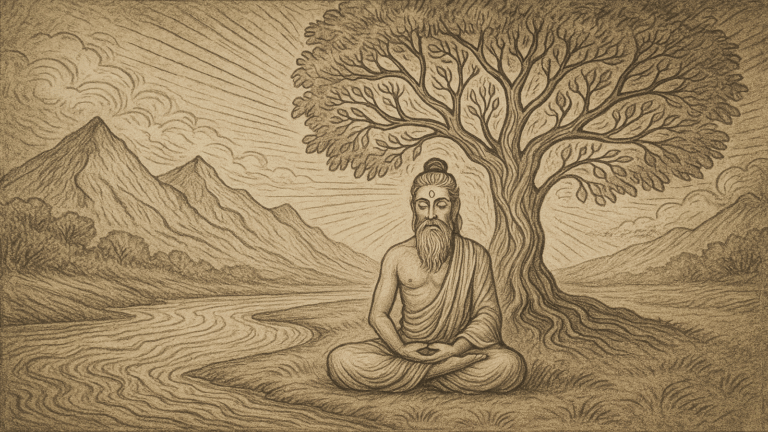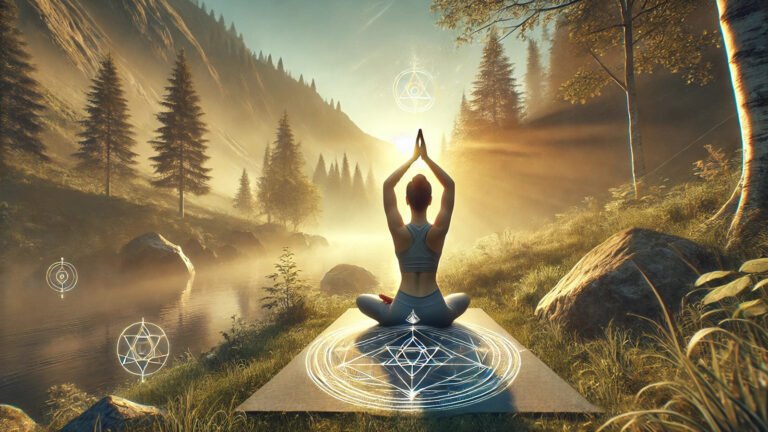Yog's Expression Across the World
It is fascinating to explore who first introduced yog to the world and how this sacred discipline spread across the globe. According to ancient belief, Lord Hiranyagarbha is considered the original proponent of yog. The scriptures state, “हिरण्यगर्भ योगस्य वक्तानान्यः पुरातनाः”, meaning that no one other than Lord Hiranyagarbha is the primary originator of yog.
Supporting this, Lord Krishna declares in the Bhagavad Gita, “Arjun, I first imparted the knowledge of yog to Sury, the Sun God, who then passed it on to Manu. Manu taught it to his son Ikshvaku and subsequently to other kings.” Thus, the yogic tradition flowed continuously through the Suryavanshi and Chandravanshi royal lineages, allowing kings like Janak to attain spiritual heights and be honored as Rajrishis—royal sages.
Indian tradition holds that the current cosmic cycle, or Kalp, spans roughly two billion years, with many previous Kalps predating it. Yogvidya—the science of yog —has existed since the very dawn of this creation. The Veds, which are among the oldest known scriptures, contain references to yog, indicating its ancient roots. The Puran recount that in the earliest age of creation, Lord Narayan, in the form of Hiranyagarbh Brahma, imparted this yogic knowledge to sages such as Sank and others, who were born from Brahma.
These sages, pure-hearted and spiritually inclined, adopted the path of Brahmayog and chose lives of renunciation. In this path of detachment (Nivrutti Marg), renowned sages such as Sanak, Sanatan, Sanandan, Sanatkumar, Kapil, Aasuri, Vadhu, Panchashikha, Narad, and Shukadev became prominent. Within this tradition, yog was practiced and transmitted in various forms including Sankhya Yog, Jnan Yog, and Brahm Yog.
For thousands of years, these sages lived in secluded forests and undertook intense spiritual practices. Through deep meditation and penance, they achieved superconscious states and heard the divine voice. Gathering together, they compiled the sacred knowledge they received directly from the Divine into the Veds. These Shrutis became the foundation of Brahmavidya—“the science of realizing the Supreme Consciousness.” Yog is the practical path for attaining this supreme realization.
The sages recognized yog as a means to overcome intense worldly suffering. Out of compassion for humanity, they systematized yog into a structured discipline. When practiced with dedication and sincerity, this system enables seekers to attain inner peace and ultimately move toward liberation (moksh). This invaluable gift of yog has been passed down through generations for the well-being of all humankind.
Just as a person with vision guides someone who is blind, an experienced yogi leads others along the true spiritual path. Inspired by the wisdom of the ancient masters, common people began to follow in their footsteps. The great yogis of old thus organized yog into a step-by-step journey that, when practiced with devotion and perseverance, leads the seeker to the ultimate state of samadhi and liberation.
Influence of Indian Yog in the World
Indian culture is deeply rooted in Vedic tradition. The foundation of Indian spiritual and philosophical thought lies in the Vedas, which are further expanded upon through texts such as the Upanishads, Puranas, Upapuranas, the Mahabharata, Ramayana, Smritis, and other theological scriptures. Within these texts, yoga is not merely mentioned—it is explored in depth, both in concept and practice. Alongside terms like Brahma, Atma, Jiva, Ishwar, Dharma, and Moksha, the term yoga holds significant importance.
These scriptures provide not only philosophical discussions but also detailed guidelines on the practice of yoga. Numerous stories highlight the lives of yogis and describe deities as being empowered with yogic energy. Among the six classical schools of Indian philosophy (Shad Darshanas), the system of yoga—codified by the sage Patanjali in the Yoga Sutras—stands as an independent and authoritative text known as Yogadarshan. Over time, numerous other texts and treatises have been composed, inspired by this foundational work. Hence, yogic literature is both ancient and vast, encompassing a wide spectrum of thought and disciplines.
Yoga Vidya, or yogic wisdom, outlines profound spiritual principles. It presents not only philosophical insights but also structured paths of spiritual practice. One of the most prominent forms is Ashtanga Yoga (the Eightfold Path), which emphasizes a disciplined journey through physical, mental, and spiritual stages. Yoga is deeply intertwined with other Indian spiritual streams such as Mantra, Tantra, Karma, Jnana, and Bhakti. Its ultimate aim is Moksha—liberation from the cycle of birth and death. This path, however, is demanding and requires rigorous discipline, which leads many to believe that the full yogic discipline is challenging to follow, especially in the current age of Kali Yuga.
Despite this, there is a growing curiosity and enthusiasm for yoga around the world. Even in modern, materialistic societies—especially in the West—people are beginning to realize that yoga offers a path to inner purification, peace, and global well-being. With rising concerns about destructive technologies and existential unrest, yoga is being seen as a means to restore balance and guide humanity toward harmony.
Yoga is not confined to spiritual elevation alone. It transforms individuals by expanding their consciousness beyond ego and self-interest, nurturing a universal outlook. As both a spiritual science and a practical discipline, yoga is a timeless, universal truth. It is not merely a philosophy but a living, experiential path. Anyone can study and apply it in daily life.
Thousands of years ago, the great ascetic sages of Arya Varsha (ancient India) attained direct realization of Brahman—the Supreme Reality—through disciplined yogic practice. They then shared this knowledge selflessly for the benefit of all mankind. Through centuries, India has continued to produce spiritually realized beings who have preserved and transmitted this yogic wisdom through sacred traditions. This enduring legacy is a testament to the profound and transformative influence of Indian yoga on the world.
What is Yog ?
The Veds of India are widely regarded as the oldest extant texts in the world. They contain profound insights into Brahmavidya—the ultimate spiritual knowledge—defined as the science of realizing the Supreme Brahman. This Brahmavidya is synonymous with Yogvidya, as reflected in the Srimad Bhagavad Gita, where the essence of Yogshastra is extensively elaborated by Lord Krishna.
In fact, every chapter of the Bhagavad Gita is titled with the word “Yog,” signifying its thematic foundation in Yogic wisdom. At the conclusion of each chapter, Maharishi Vedvyas affirms this connection with the declaration:
ॐ तत्सदिति श्रीमद् भगवद् गीतासुपनिषदसु ब्रह्मविद्यायां योगशास्त्रे श्रीकृष्णार्जुनसंवादे… योगो नाम… अध्यायः॥
“Om tatsat—thus concludes the Upanishadic discourse known as the Brahmavidya and the Yogshastra in the dialogue between Shri Krishna and Arjun”
This clearly affirms that Brahmavidya and Yogshastra are not distinct disciplines but are, in essence, one and the same.
According to the scriptures, Brahmatattva—the Supreme Principle—is the ultimate reality, beyond which nothing remains to be known. Realization of this truth leads to liberation (moksh), the release from the cyclical bondage of birth and death. Therefore, Yogvidya is the knowledge that leads to immortality and is considered true knowledge, as emphasized in the scriptural maxim:
“सा विद्या या विमुक्तये।” — “That alone is true knowledge which leads to liberation.”
From this perspective, conventional academic degrees, while valuable for worldly sustenance, are inadequate for spiritual liberation. Such worldly education (avidya) cannot liberate the soul from the repetitive cycle of reincarnation. In contrast, Yog is the true path to salvation. As one of the six classical schools of Indian philosophy (Shad Darshans), Yogshastra represents a time-honored tradition of self-realization.
Yogvidya aims to provide direct experiential knowledge of Brahmatattva. However, theoretical understanding alone is insufficient; true comprehension requires personal realization. Just as scientific hypotheses must be tested through experimentation, the truths of Yog must be verified through disciplined practice. Thus, both scriptural study and practical application are essential for the realization of the Supreme.
In today’s world, where interest in Yog is surging globally, it is natural to inquire into its true essence and the reason for its universal appeal. Maharishi Patanjali, the compiler of the Yog Sutra and founder of Yogdarshan, defines Yog as:
“योगश्चित्तवृत्तिनिरोधः” — “Yog is the control on the fluctuations of the mind.”
When the senses are withdrawn and the mind becomes still, one attains Super Consciousness. In his authoritative commentary, Maharishi Vyas further clarifies this concept by stating:
“योगः समाधिः” — “Yog is Samadhi (deep meditative absorption).”
Evolution of the word Yog
The term Yoga is derived from the Sanskrit root “yuj” (युज्). According to the grammatical treatise of Maharishi Panini, the root “yuj” holds three primary interpretations across different verb groups (dhatu-gana):
-
In the Rudhadi group, it signifies union or joining (युजिर योगे),
-
In the Divadi group, it means absorption or Samadhi,
-
And in the Churadi group, it refers to restraint or control.
Based on the first meaning, Yoga implies the union of the individual soul (जीवात्मा) with the Supreme Consciousness (परमात्मा). In the second context, it denotes a state of deep meditative absorption (समाधि), as reflected in Vyas’s commentary on the Yog Sutras, where he defines Yog as Samadhi. The Bhojavritti elaborates this interpretation: “योगो युक्तः समाधिः। युज् समाधौ इति।” (yogo yuktah samadhihi – yuj samadhau iti ), indicating that Yog is synonymous with Samadhi.
The third interpretation, restraint, forms the basis of Maharishi Patanjali’s classical definition:
“योगश्चित्तवृत्तिनिरोधः” (Yogaschitta-vriti-nirodhah),
meaning Yog is the cessation or control over the fluctuations of the mind. Thus, all three traditional interpretations of the root “yuj” — union, concentration, and restraint — are intrinsically linked to the concept of Yog.
Moreover, the word Yog is used both as a means and as a goal. As a practice, Yog refers to the disciplined methods through which the state of Samadhi is achieved. As a result, it refers to the ultimate union — the realization of one’s true Self and unity with the Divine. This is emphasized in the Yog Darshan by Patanjali:
“तदादृष्टुः स्वरूपे अवस्थानम्” (Tadadrastuh svarupe avasthanam) —
Then the seer rests in their true nature.
Through sustained yogic discipline, the practitioner transcends sensory distractions and becomes established in the pure Self (Atma), ultimately realizing Brahmatattva — the Supreme Truth. This absolute reality is beyond the constraints of time, space, and the cycle of birth and death. It is non-dual, eternal, unchanging, all-knowing, stable, transcendent and infinite — the ultimate aim of Yog.
Various Definitions of Yog
The primary definition of yog is given by Maharishi Patanjali in the Yoga Sutras:
“योगश्चित्तवृत्तिनिरोधः”
(Yog is the cessation or control over the fluctuations of the mind). This means that the complete control and restraint of the mind is yog.
In the Kathopanishad, it is stated:
“ताम् योगमिति मन्यन्ते स्थिरामिन्द्रियधारणाम्।,”
(tam yogmiti manyante sthiramindriydharnam ) which means that yog is the practice of subduing the senses by the practitioner in a fixed form. Here, the control of the senses is considered yog.
Another definition of yog is: “परोहियोगोमानस: समाधि:,”
( parohiyogomanasah samadhihi ) which means that the ultimate yog is the state of meditative trance or Samadhi.
A similar definition is presented in the Shrimad Bhagavad Gita:
“समत्वं योग उच्यते,”
( samtvam yog uchate ) which translates to “Equanimity is called yoga.” This implies that yog is the attainment of a balanced and calm state of mind, where the individual transcends dualities such as happiness-sorrow, sin-virtue, and cold-heat.
In the Bhagavad Gita, another definition is given:
“योग: कर्मसु कौशलम्,”
( Yogah Karmshu Kaushalam ) which means that yog is the skillfulness or excellence in action. When a person performs actions with natural intuition and without attachment, leading to no bondage, it is considered yog.
Yogvasisth describes yog as the act of crossing the ocean of the material world, indicating the transcendence of worldly attachments. According to the Samkhya philosophy:
“पुप्रकृत्योववयोगेप योगेततअमर्धधयत ।”
meaning that yog is the separation of Purusha (the Self) and Prakriti (the material world), leading to the realization of the Self in its pure form.
Finally, another definition from yog states:
“संयोगो योगो इत्युक्तो जीवात्मा परमात्मनो,”
(Sanyogo Yogo Ityukto Jivatma Parmatmano ) which means that yog is the union of the individual soul (Jivatma) with the supreme soul (Paramatma), signifying the unity of the self with the universe or God.
Wrapping Up
From its profound roots in ancient Indian tradition to its global presence today, Yog stands as a timeless path to inner harmony and self-realization. The expression of Yog across the world reflects not only a physical discipline but also a shared spiritual quest for balance and peace. The influence of Indian Yog has transcended cultural boundaries, offering tools for wellness, clarity, and conscious living.
Understanding what Yog truly is reveals it as more than just postures—it is a holistic system that integrates body, mind, and soul. The evolution of the word ‘Yog’ through Sanskrit grammar and philosophical interpretation highlights its depth, showing that it means union, concentration, and restraint—all essential to spiritual practice. The various definitions of Yog across scriptures further affirm its universality and adaptability, each shedding light on different dimensions of the same eternal truth.
Ultimately, Yog is not confined to any one form or tradition. It is a living philosophy, a discipline, and a journey—from the fragmented to the whole, from the self to the Supreme.



